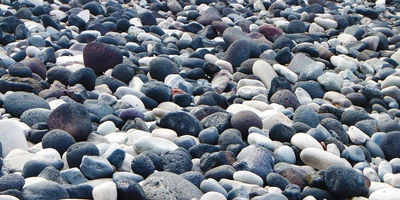|
 In one place in the Caucasus, not far from the beach, pebbles were taken for construction. As a result, the beach disappeared. It turns out that the builders have disturbed the balance between the amount of inflow and outflow of pebbles. They forgot that pebbles and sand do not lie motionless on the shore, or perhaps they did not know about the existence of stone rivers. In one place in the Caucasus, not far from the beach, pebbles were taken for construction. As a result, the beach disappeared. It turns out that the builders have disturbed the balance between the amount of inflow and outflow of pebbles. They forgot that pebbles and sand do not lie motionless on the shore, or perhaps they did not know about the existence of stone rivers.
Going into foam, rattling angrily on the rifts, a mountain river hurries to the sea. Shallow, but strong current. Wiggle the toe of your boot, the agitated sand will burst into an instant cloud of rupture, as if alive, a pebble will jump up. The water will immediately pick them up, sweep them away ... Mountain rivers bring an enormous amount of material to the sea. If all of it remained motionless, whole mountains would long ago have grown at the mouths of the rivers. But the stone and sand, as if infected from the water by the desire for wandering, flow further, moving along the coast of the sea. Traveling is so interesting!
How do stones and sand move, what, what force helps them? Sea. Waves rhythmically, one by one running ashore, gently push the grains of sand and stone. These seemingly imperceptible jolts, acting one after the other, turn into a tangible force. No wonder there is a proverb: "A drop hollows a stone."
Stone and sandy rivers flow not only along the coast, but also along the seabed in the coastal zone. The width of the surface pebble rivers reaches 30-40 meters, underwater - 15-20. Sandy rivers flood sometimes up to two kilometers wide. There is such a river in the Baltic States, in the Riga region.
The speed of the flow of sandy-stone rivers depends on the strength of the waves and their direction. Where the waves roll onto the shore at an angle of 45 degrees, the speed is greatest. Shingle can flow at a speed of 1.8 kilometers per hour, sand - at a speed of 2.8 kilometers per hour. This is almost the speed of a pedestrian.
Interestingly, in some parts of the coast, coarse material moves in one direction along the coast, and small material in the opposite direction. This, at first glance, unnatural phenomenon can be explained very simply. The sea can simultaneously roll waves, different not only in size and strength, but also in direction. Strong, rare waves push rock and sand. Weak, but following one after another after a short period of time, they cannot shake the stone, sand is their prey. On the Caucasian coast, for example, pebbles go southeast to Gudauta, and gravel flows to Pitsunda.
The high water content of ordinary, water, rivers is estimated by the annual flow. For example, the annual runoff of the world's greatest river, the Amazon, is 4000 cm3, and the Don, 28 km3. The concept of annual runoff can also be applied to stone rivers. Let's take the Batumi region, where during the year the pebble flows along the beach in the amount of 70,000 - 80,000 m3. Not so little! If it were possible to collect all the pebbles "leaking" in a year, the result would be a solid slide, not inferior in height to the Peter and Paul Fortress in St. Petersburg.
 Sand-stone rivers flow along the sea, the outlines of the shores change over time, the bays are shallower, the capes are erased, the coastline is more and more leveled. Sand-stone rivers flow along the sea, the outlines of the shores change over time, the bays are shallower, the capes are erased, the coastline is more and more leveled.
Once upon a time, the geographical map looked different. We can look into the past and, analyzing the strata of coastal sediments, see how it was, recreate, in scientific terms, the paleographic setting.
Not only the past is subject to people who have comprehended the secrets of the flow of sandy-stone rivers. They can make "amendments" to the shape of the coast. And, in any case, to prevent the disappearance of good and comfortable beaches.
To protect the shores from the waves, breakwaters are usually placed. You've probably seen concrete structures protruding into the sea, looking like gouges! They take on the main blow of the wave coming from the sea, dampen its power. Breakwaters not only weaken the force of the waves, but also change the angle at which they reach the shore.
Knowledge of the laws of sand and stone rivers is necessary for engineers. Otherwise, when designing a new port or canal, they may choose a bad place, and the newly built port will quickly start to grind, the canal - filled with sand ...
L. Ilyina
Read now
All recipes
|
 In one place in the Caucasus, not far from the beach, pebbles were taken for construction. As a result, the beach disappeared. It turns out that the builders have disturbed the balance between the amount of inflow and outflow of pebbles. They forgot that pebbles and sand do not lie motionless on the shore, or perhaps they did not know about the existence of stone rivers.
In one place in the Caucasus, not far from the beach, pebbles were taken for construction. As a result, the beach disappeared. It turns out that the builders have disturbed the balance between the amount of inflow and outflow of pebbles. They forgot that pebbles and sand do not lie motionless on the shore, or perhaps they did not know about the existence of stone rivers. Sand-stone rivers flow along the sea, the outlines of the shores change over time, the bays are shallower, the capes are erased, the coastline is more and more leveled.
Sand-stone rivers flow along the sea, the outlines of the shores change over time, the bays are shallower, the capes are erased, the coastline is more and more leveled.




